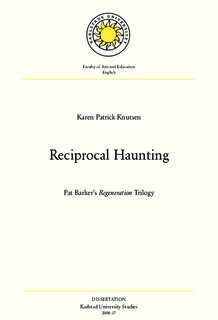| dc.description.abstract | Pat Barker’s fictional account of the Great War, The Regeneration Trilogy, completed in 1995, is considered to be her most important work to date and has captured the imagination of the reading public as well as attracting considerable scholarly attention. Although the trilogy appears to be written in the realistic style of the traditional historical novel, Barker approaches the past with certain preoccupations from 1990s Britain and rewrites the past as seen through these contemporary lenses. Consequently, the trilogy illustrates not only how the past returns to haunt the present, but also how the present reciprocally haunts perceptions of the past. The haunting quality of the trilogy is developed through an extensive, intricate pattern of intertextuality. This reciprocal haunting at times breaks the realistic framework of the narrative, giving rise to anachronisms.
This study offers a reading of trauma, class, gender and psychology as thematic areas where intertexts are activated, allowing Barker to revise and re-accentuate stories of the past. Drawing on Michel Foucault’s concept of discourse and Mikhail Bakhtin’s notion of dialogue, it focuses on the trilogy as an interactive link in an intertextual chain of communication about the Great War. Received versions of history are confirmed, expanded on and sometimes questioned. What is innovative about the trilogy is how Barker incorporates discursive formations not only from the Great War period, but from the whole twentieth century. The Great War is regenerated and transformed as it passes from one dialogic context to another. My reading shows that the trilogy presents social structures from different historical epochs through dialogism and diachronicity, making the present-day matrices of power and knowledge that continue to surround, determine and limit people’s lives highly visible. The Regeneration Trilogy regenerates the past, simultaneously confirming Barker’s claim that the historical novel can also be “a backdoor into the present”. | en |
